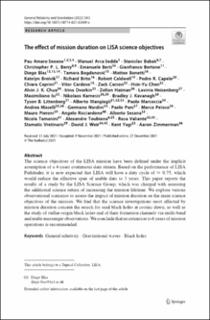| dc.contributor.author | Amaro Seoane, Pau | |
| dc.contributor.author | Arca Sedda, Manuel | |
| dc.contributor.author | Babak, Stanislav | |
| dc.contributor.author | Berry, Christopher P. L. | |
| dc.contributor.author | Berti, Emanuele | |
| dc.contributor.author | Bertone, Gianfranco | |
| dc.contributor.author | Blas, Diego | |
| dc.contributor.author | Bogdanović, Tamara | |
| dc.contributor.author | Bonetti, Matteo | |
| dc.contributor.author | Breivik, Katelyn | |
| dc.contributor.author | Brito, Richard | |
| dc.contributor.author | Caldwell, Robert | |
| dc.contributor.author | Capelo, Pedro R. | |
| dc.contributor.author | Caprini, Chiara | |
| dc.contributor.author | Cardoso, Vitor | |
| dc.contributor.author | Carson, Zack | |
| dc.contributor.author | Chen, Hsin-Yu | |
| dc.contributor.author | Chua, Alvin J. K. | |
| dc.contributor.author | Dvorkin, Irina | |
| dc.contributor.author | Haiman, Zoltan | |
| dc.contributor.author | Heisenberg, Lavinia | |
| dc.contributor.author | Isi, Maximiliano | |
| dc.contributor.author | Karnesis, Nikolaos | |
| dc.contributor.author | Kavanagh, Bradley J. | |
| dc.contributor.author | Littenberg, Tyson B. | |
| dc.contributor.author | Mangiagli, Alberto | |
| dc.contributor.author | Marcoccia, Paolo | |
| dc.contributor.author | Maselli, Andrea | |
| dc.contributor.author | Nardini, Germano | |
| dc.contributor.author | Pani, Paolo | |
| dc.contributor.author | Peloso, Marco | |
| dc.contributor.author | Pieroni, Mauro | |
| dc.contributor.author | Ricciardone, Angelo | |
| dc.contributor.author | Sesana, Alberto | |
| dc.contributor.author | Tamanini, Nicola | |
| dc.contributor.author | Toubiana, Alexandre | |
| dc.contributor.author | Valiante, Rosa | |
| dc.contributor.author | Vretinaris, Stamatis | |
| dc.contributor.author | Weir, David J. | |
| dc.contributor.author | Yagi, Kent | |
| dc.contributor.author | Zimmerman, Aaron | |
| dc.date.accessioned | 2023-02-09T09:42:36Z | |
| dc.date.available | 2023-02-09T09:42:36Z | |
| dc.date.created | 2022-05-09T12:49:02Z | |
| dc.date.issued | 2022 | |
| dc.identifier.citation | Amaro Seoane, P., Arca Sedda, M., Babak, S., Berry, C. P., Berti, E., Bertone, G., ... & Zimmerman, A. (2022). The effect of mission duration on LISA science objectives. General Relativity and Gravitation, 54(1), 3. | en_US |
| dc.identifier.issn | 0001-7701 | |
| dc.identifier.uri | https://hdl.handle.net/11250/3049562 | |
| dc.description.abstract | The science objectives of the LISA mission have been defined under the implicit assumption of a 4-years continuous data stream. Based on the performance of LISA Pathfinder, it is now expected that LISA will have a duty cycle of ≈0.75 , which would reduce the effective span of usable data to 3 years. This paper reports the results of a study by the LISA Science Group, which was charged with assessing the additional science return of increasing the mission lifetime. We explore various observational scenarios to assess the impact of mission duration on the main science objectives of the mission. We find that the science investigations most affected by mission duration concern the search for seed black holes at cosmic dawn, as well as the study of stellar-origin black holes and of their formation channels via multi-band and multi-messenger observations. We conclude that an extension to 6 years of mission operations is recommended. | en_US |
| dc.language.iso | eng | en_US |
| dc.publisher | Springer | en_US |
| dc.rights | Navngivelse 4.0 Internasjonal | * |
| dc.rights.uri | http://creativecommons.org/licenses/by/4.0/deed.no | * |
| dc.title | The effect of mission duration on LISA science objectives | en_US |
| dc.title.alternative | The effect of mission duration on LISA science objectives | en_US |
| dc.type | Peer reviewed | en_US |
| dc.type | Journal article | en_US |
| dc.description.version | publishedVersion | en_US |
| dc.rights.holder | The authors | en_US |
| dc.subject.nsi | VDP::Matematikk og Naturvitenskap: 400::Fysikk: 430 | en_US |
| dc.source.pagenumber | 0 | en_US |
| dc.source.volume | 54 | en_US |
| dc.source.journal | General Relativity and Gravitation | en_US |
| dc.source.issue | 1 | en_US |
| dc.identifier.doi | 10.1007/s10714-021-02889-x | |
| dc.identifier.cristin | 2022657 | |
| cristin.ispublished | true | |
| cristin.fulltext | original | |
| cristin.qualitycode | 1 | |

